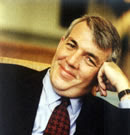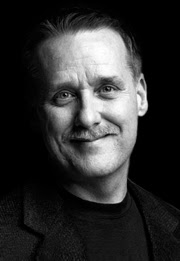If you’re a fabulously successful interactive entrepreneur whose last six startups have made a killing in the market and you’re looking for a new place to park some cash, Mike Hughes wants your money.
 Admittedly, that sounds somewhat odd, for Mr. Hughes, the longtime President and Creative Director of The Martin Agency in Richmond, Virginia, is highly successful himself. His advertising agency helped launch the ad industry’s Second Creative Revolution in the 1980’s and has been on a tear ever since. Martin’s latest triumphs include its stewardship of the renowned Geico insurance account, and its win (after a controversial and protracted review process) of the Wal-Mart retail account.
Admittedly, that sounds somewhat odd, for Mr. Hughes, the longtime President and Creative Director of The Martin Agency in Richmond, Virginia, is highly successful himself. His advertising agency helped launch the ad industry’s Second Creative Revolution in the 1980’s and has been on a tear ever since. Martin’s latest triumphs include its stewardship of the renowned Geico insurance account, and its win (after a controversial and protracted review process) of the Wal-Mart retail account.
Nonetheless, Mr. Hughes wants to pick your pocket — for your own good: He wants to establish the world’s first endowed professorship in interactive advertising at Virginia Commonwealth University’s Adcenter, the first accredited graduate program in advertising to combine academic study of business-communications strategy and brand management with a creative program for art directors and copywriters.
“We’re really trying to teach the next generation of industry leaders, and interactive is by far the fastest growing part of that,” Mr. Hughes, the chairman of VCU Adcenter’s Board of Directors, told me during a recent visit to Manhattan. “There aren’t enough people with experience in digital advertising. It feels to us there should be a program at the Adcenter built specifically to make that happen – to improve education in this area, from media to creative to strategy to brand management. And right now is the time, while the rules are still being written.”
The enthusiasm of Mr. Hughes and his Adcenter colleagues for interactive and its opportunities is of no small import to marketers, agencies, and media. The Second Creative Revolution led by agencies like Martin, Chiat/Day, Wieden + Kennedy, Fallon, Goodby Silverstein, and others transformed the ad industry by making advertising culturally relevant to a rising generation of consumers. Their rebellion regionalized — and then globalized — a business that theretofore had been New York-centric. That combination of decentralization and postmodern edginess, in turn, drew new creative energy into agencies at a time when maturing consumer businesses in the U.S. desperately needed to shake up the way they marketed products and services to fragmenting, jaded audiences.
But during the first decade of the interactive era, the agencies that defined this Second Creative Revolution had their sights trained largely on traditional media. That the shops that imagined their way into the signature campaigns of the 1980s and 1990s are now innovating their way into interactive promises a new creative surge in marketing – and even more intimate levels of engagement with consumers.
“Creatives today have a facility with technology — they don’t need to think about the technology to use it, while for my generation, it doesn’t come naturally,” said Mr. Hughes. Fifty-nine years old, he is a second-generation ad man; his father was a production manager, back in the days when writers wrote copy, handed it over to art directors for a layout and an illustration, and then trafficked it to production heads who would supervise photography, typography and the other components of realization.
“What the new generation of creatives hasn’t necessarily learned,” Mr. Hughes continued, “is how to engage as deeply as we did.”
 Which is why the development of an interactive program at VCU Adcenter is so exciting. Inspired and led initially by Diane Cook-Tench, formerly an art director at the Martin Agency, Adcenter was founded 12 years ago to train new generations of agency leadership, inured to the philosophy that creativity, design, innovation, strategy, and brand management – all too typically siloed at marketers and agencies alike — had to be integrated in order to drive business growth. But, as advanced doyens of contemporary marketing understand, it wasn’t until the interactive era that technology not only allowed for but required the full amalgamation of strategy, channel, and content in marketing communications. Hence the emphasis on future media – known and as-yet undiscovered – that has been an emphasis at Adcenter since former Ogilvy & Mather Worldwide Chief Creative Officer Rick Boyko joined it as managing director in 2003.
Which is why the development of an interactive program at VCU Adcenter is so exciting. Inspired and led initially by Diane Cook-Tench, formerly an art director at the Martin Agency, Adcenter was founded 12 years ago to train new generations of agency leadership, inured to the philosophy that creativity, design, innovation, strategy, and brand management – all too typically siloed at marketers and agencies alike — had to be integrated in order to drive business growth. But, as advanced doyens of contemporary marketing understand, it wasn’t until the interactive era that technology not only allowed for but required the full amalgamation of strategy, channel, and content in marketing communications. Hence the emphasis on future media – known and as-yet undiscovered – that has been an emphasis at Adcenter since former Ogilvy & Mather Worldwide Chief Creative Officer Rick Boyko joined it as managing director in 2003.
(For Mr. Boyko, running Adcenter clearly is more than a job: In March, he announced that he and his wife Barbara are contributing $1 million to the school’s development campaign and a scholarship program.)
Integration also has undergirded the growth of the Martin Agency, a 400-person, independent operating unit of the Interpublic Group of Companies, in recent years. In several conversations over the past few months, Mr. Hughes, a warm, bearish fellow with a trace of the South of in his voice, told me that, while Martin had long benefited from its manageable size, it was the arrival of the Geico account in 1994 that changed the game for them.
“We didn’t have a direct-marketing company, so we bought one in New York City, moved it to Richmond, and gave them autonomy,” Mr. Hughes recalled. “The president there said, ‘Wait, there’s an artificial wall between us,’ and eventually we literally broke down the walls and moved them into our main agency building.
“Geico became one of our direct agency’s clients. It was a little government employees’ insurance company from Washington. When we blended our agencies together, we got Geico over here in the main agency. And we learned a lot from the direct people – they’ re much more responsive than main agency creative people. And the direct creatives have learned from general creativity and innovation. Geico – the gecko, the caveman — is the product of that. It’s got sound roots in DR: We have to get the phone to ring and the computer to click. But we have, at same time, created a brand for them.”
Martin’s interactive capabilities benefited from the combination. In the mid-1990’s, when The Coca Cola Company was searching for its first interactive agency, the marriage of audience-gathering creative skills and direct-response accountability persuaded the soft drink maker to give the Richmond shop the assignment to build Coke’s first Web site. Today, interactive is Martin’s fastest-growing division — “by far,” according to Mr. Hughes.
Also integrated and co-located with creative and account management is media. Indeed, even when Martin doesn’t own the client’s media business, media planners are likely to be on the account’s “ownership team.”
“You want to know what’s possible and what’s not possible,” Mr. Hughes explained. “Media planners can bring in ideas that others can’t.” He believes the agency’s commitment to connecting marketing’s blocking-and-tackling disciplines with innovative creative has contributed to Martin’s growth and skein of account wins — including the securing of the Wal-Mart account. He mused about Martin’s resistance to the unbundling of creative and media in the late 20th Century. “We were in an unfashionable place 10 years ago,” Mr. Hughes said. “Now we’re not.”
One might say similar things about the VCU Adcenter that he chairs. While many may have questioned whether an industry fixated around portfolio schools, “killer books,” and “great reels” would beat a path to an accredited master’s degree program at a major university in the heart of Virginia, today its student body of 190 and full-time faculty of 11 attest to Adcenter’s centrality. Endowed chair or not, when its interactive program gets structured and funded – and while they’d welcome your donations, what Mr. Hughes, Mr. Boyko and their colleagues really want right now is your ideas – that importance will only grow. For this is a school that understands the integrated moment that is rocking the marketing world.
“When you get all these people together, divisions start falling away,” Mr. Hughes told me, speaking both of his agency, and of the potential for all agencies as they embrace interactive. “Media people say, ‘You can do this in creative?’ Creatives say, ‘Can you do this in media?’ You start becoming creative in everything. You still have expertise in the room, but everyone is helping everything get better.
“It’s the Bernbach vision of putting art directors and copywriters together in a room,” Mr. Hughes concluded. “Writ large.”
